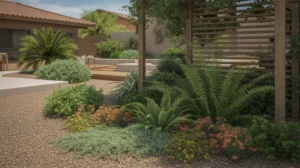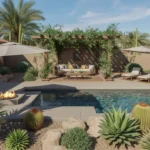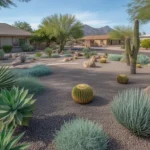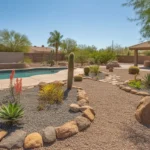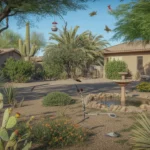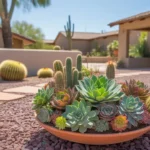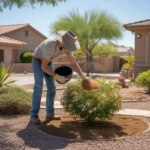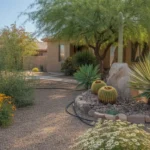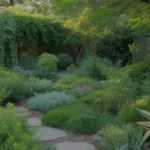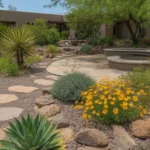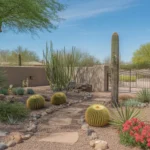Shady spots in Gilbert yards may seem tricky to landscape, but with a little planning and some desert-smart choices, those cooler corners can become some of the most inviting areas in your yard. This guide walks you through how to assess your shade, choose the right plants, and care for them year-round.
Assess the Shade in Your Yard
Not all shade behaves the same. In Gilbert, full shade might occur on the north side of walls or under large trees, while other areas receive partial or filtered sunlight. Start by observing how much direct sun each shady area gets throughout the day and what causes the shade—structures, trees, or nearby buildings. Reflective surfaces can also affect how much light reaches your plants.
Understanding these nuances will help you match plants to their most comfortable spots. A local nursery or garden center can be a helpful resource for identifying shade types and selecting suitable species.
Choose Shade-Tolerant Plants That Thrive Locally
Shade-tolerant plants for the desert exist, and while the options may be more limited than sun-loving varieties, you can still create a rich, layered design. Look for species that can handle the heat and aridity of zones 9 and 10 while thriving without direct sun.
- Foxtail fern (Asparagus densiflorus)
- Cast iron plant (Aspidistra elatior)
- Coral bells (Heuchera sanguinea)
- Japanese boxwood (Buxus microphylla)
- Variegated ginger (Alpinia zerumbet)
- Elephant’s food (Portulacaria afra)
Mix foliage shapes and colors for visual variety, and group plants by their light and water needs to make care easier over time.
Improve Soil to Help Shade Plants Flourish
Shade areas may stay cooler, but Gilbert’s dry climate still dries out soil quickly. Amending your soil with compost before planting helps hold moisture and nutrients. Loosen the native soil to a depth of 8 inches and work in several inches of well-aged compost.
If your yard has clay soil or drainage issues, raised beds or mounded planting areas can help. These should be filled with amended soil for the best growing conditions. Aim for a rich, sponge-like texture that retains moisture without becoming soggy.
Use Groundcovers to Cool and Protect Soil

Groundcovers aren’t just attractive — they’re practical. In shaded areas, they help cool the soil, reduce moisture loss, and add another layer of texture. Plant them close together to help them fill in quickly.
- Sweet woodruff (Galium odoratum)
- Creeping thyme (Thymus serpyllum)
- Ajuga (Ajuga reptans)
- Mondo grass (Ophiopogon japonicus)
- Spotted deadnettle (Lamium maculatum)
Once planted, keep them consistently watered their first season, then taper to a sustainable schedule.
Apply Mulch to Hold Moisture and Suppress Weeds
Mulch is essential in shady areas — not only to suppress weeds but to lock in moisture. A 2- to 3-inch layer of mulch around your plants helps moderate soil temperatures and improve long-term soil health. In Gilbert, gravel mulch can be a smart option because it allows water to reach the roots while shielding the soil from evaporation.
Make sure to keep mulch a few inches away from plant stems and trunks to prevent moisture-related rot. Replenish annually to maintain coverage.
Supplement Shade Strategically
Sometimes even \”shade\” in Gilbert isn’t shady enough — especially during summer afternoons. If sensitive plants show signs of sun stress, consider adding protective elements. This might include:
- Shade sails
- Lath panels
- Freestanding pergolas
- Vertical plantings or trellises for natural shade
Your goal is to create filtered light, not complete darkness. Shade structures should complement your garden design while offering gentle protection.
Water Wisely for Healthier Plants
Even in the shade, plants in Gilbert need consistent watering. Deep, infrequent watering encourages strong roots. Drip irrigation and soaker hoses are ideal tools to deliver water directly where it’s needed — the root zone.
Water in the early morning to help plants start the day well hydrated. In summer, this might mean watering twice a week; in winter, once every 10 days may be enough. Check moisture levels by feeling the top inch of soil — adjust as needed.
Keep an Eye Out for Stress or Pests
Watch your plants regularly for changes. Wilting, yellowing, or stunted growth might indicate overwatering, under-watering, poor drainage, or pests. Common desert garden issues include aphids, mealybugs, and powdery mildew.
Good air circulation, avoiding overhead watering, and using natural treatments like insecticidal soap can help manage these problems before they spread.
With the right planning and plant choices, shady corners in your Gilbert yard can become cool, calming highlights. Local nurseries and desert gardening resources are great partners if you want to dive deeper into shade strategies tailored to your space.

